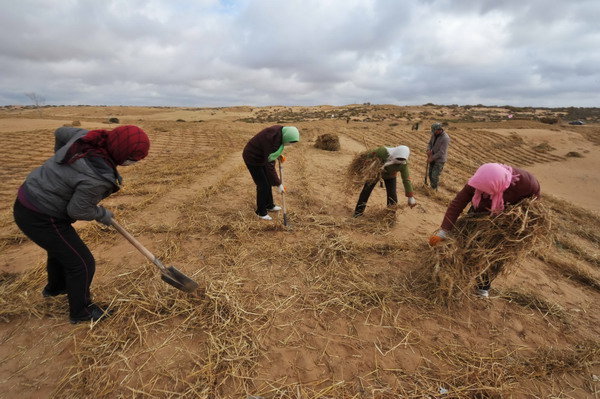Warning over desertification
|
|
|
Farmers in Yanche county, the Ningxia Hui autonomous region, make a joint effort to tackle the process of desertification on Oct 26 by making a net to contain the sand in the Maowusu Desert. [Photo/Xinhua] |
Forestry experts warned degraded grasslands are likely to speed up the processes of soil erosion and desertification, feeding the sandstorms that usually sweep North China in the spring.
"Overgrazing causes about 90 percent of grassland erosion, extending from the Qinghai-Tibet Plateau to the arid reaches of the Inner Mongolia autonomous region," Zhang Xinshi, professor of the Institute of Botany at the Chinese Academy of Sciences, said on Friday at the Sino-German expert consultation on climate change and combating desertification project in Beijing.
Restoring grasslands and controlling desertification have become an important part of China's fight against climate change, said Liu Tuo, director-general of the State Forestry Administration's national bureau to combat desertification.
While grasslands cover more than 40 percent of China, comprising about 400 million hectares, growing urbanization and overgrazing are encroaching on and damaging the country's green areas.
China already suffers from severe desertification, with about 2.6 million square kilometers of land - or more than 25 percent of the country's total land area - affected by the process, according to the latest statistics from the forestry administration.
It is estimated that desertification poses a threat to 400 million people who live in arid regions of China, which cover more than 33 percent of the country.
Zhang said sandstorms follow a general route in China from the northwest to the southeast of the country.
Scientists found that sandstorms form above the Qinghai-Tibet Plateau from December to March every year, before gradually moving to the north, Shanghai Morning Post reported earlier this month.
The newspaper quoted scientists from the Chinese Academy of Sciences as having said that the plateau is likely to succumb to desertification if no effective measures are taken to halt the process, especially with less rain and rising temperatures in the area.
The average temperature in China has risen 1.1 degrees over the past five decades, while there has been a corresponding rise of 0.77 degrees on the Qinghai-Tibet Plateau during the same period, according to Yang Weixi, chief engineer of the national bureau to combat desertification.
With the rising temperatures, the glacial area has contracted in western China and is currently 5.5 percent smaller than in the 1960s, Yang said.
Since the 1980s, the country's glaciers have lost nearly 587 billion cubic meters of water capacity, comparable to 10 times the annual runoff from the Yangtze River, he said.
There is expected to be a water shortage of about 20 billion cubic meters in western China by 2030, said Jiang Youxu, a scientist with the Research Institute of Forest Ecology, Environment and Protection at the Chinese Academy of Forestry.
 0
0 







